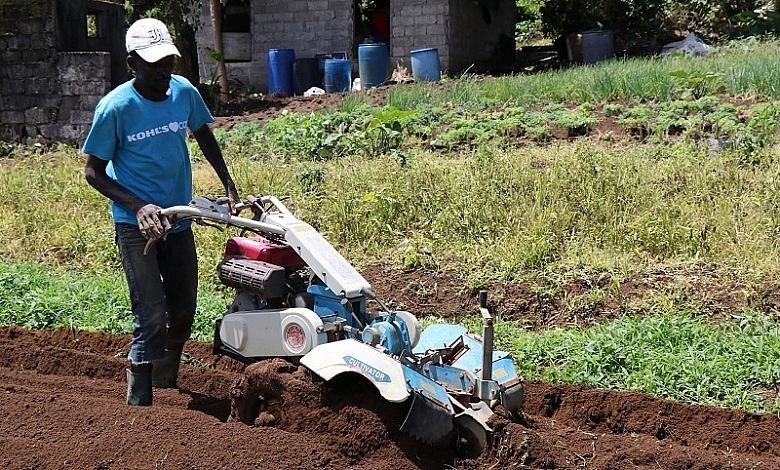Dominica’s Agricultural Sector

Dominica’s agricultural sector has been the backbone of the island’s economy, shaping its culture, livelihoods, and socio-economic development. Despite facing numerous challenges—from natural disasters to global market shifts—agriculture continues to play a crucial role. With a core focus on bananas, root crops, and recent diversification strategies—along with strong support from local and international organizations—Dominica’s agriculture continues to play a crucial role. Below is a detailed analysis of how the sector evolved historically, where it stands now, and the avenues pursued to ensure long-term sustainability and competitiveness.
Dominica’s Agricultural Sector’s Historical Overview
Dominica’s Agricultural Sector spans several decades of development, transformation, and resilience, below is a detailed analysis of how the sector evolved historically, where it stands now, and the avenues pursued to ensure long-term sustainability and competitiveness.
Agriculture in Dominica Pre: 1960s–1970s
For much of the colonial period, Dominica’s agricultural economy was rooted in plantation-based systems. Yet, unlike some other Caribbean islands, Dominica’s terrain and dense rainforests made large-scale monocropping less pervasive. The earliest commercial ventures revolved around sugarcane, coffee, and cocoa. In the early 1900s, smallholding practices began to dominate, partly due to the island’s topography and the availability of fertile volcanic soil along the slopes.
- Pre-1950s: Dominica largely adhered to colonial export models, with sugar and citrus as initial earners. Cocoa and coffee also played smaller but notable roles.
- 1950–1960: Shifting global markets and local demands saw farmers transitioning to new crops. The growth of small farms allowed families to produce both for subsistence and limited export.
- Late 1960s–1970s: Bananas started emerging as the most profitable export, paving the way for a national focus on a single-crop economy. The Dominica Banana Industry consolidated during this period, setting the stage for the next decade of agricultural expansion.
During the 1960s, external influences, including newly independent neighboring islands and changing British trade preferences, shaped Dominica’s policy environment. Despite often-limited infrastructure, many rural communities relied on cooperative networks. These laid the groundwork for more formalized groups like the Dominica Banana Growers Association (DBGA) and the Dominica Banana Marketing Corporation (DBMC). By the 1970s, bananas accounted for a growing share of the island’s exports, and more small-scale farmers specialized in cultivating high-quality fruit aimed at the UK market.
Bananas and the Rise of Export Agriculture (1980s–1990s)
From the 1980s onward, Dominica’s economy leaned increasingly on bananas. An accessible British market under preferential trade agreements propelled the banana industry to new heights, sometimes forming over 60% of agricultural export earnings. Farms of varying sizes, particularly in northeastern parishes, expanded their banana acreage, benefiting from the island’s fertile soils and abundant rainfall.
Key Developments for Dominica’s Banana Industry
- Formal Organizations:
- The Dominica Banana Marketing Corporation (DBMC) oversaw production standards, purchasing, and shipping logistics.
- The Dominica Banana Growers Association (DBGA) represented farmers’ interests, guiding negotiations and working closely with global buyers.
- Regional solidarity came via the Windward Islands Banana Growers Association (WINBAN), strengthening Dominica’s position among neighboring banana-exporting islands.
- Economic Statistics:
- By the mid-1980s, banana exports contributed an estimated 28–35% of Dominica’s GDP (according to select trade reports).
- In 1985, official tallies indicated that roughly 15,000–18,000 farmers cultivated bananas, although many held small plots under 5 acres.
- During peak seasons of the late 1980s, the island shipped 70,000–80,000 tonnes of bananas annually, meeting UK demand facilitated by preferential pricing.
- Challenges:
- Dominica’s mountainous topography hindered large-scale mechanization, causing variable yields.
- Hurricanes—most notably Hurricane David (1979) and later storms—destroyed plantations, leading to boom-bust cycles in production figures.
- Shifting trade rules in the 1990s under the World Trade Organization (WTO) complicated the previously secure UK banana market.
Transition to a Single-Crop Economy
While bananas brought economic prosperity, reliance on a single export commodity introduced vulnerabilities. Price fluctuations and natural disasters struck the sector repeatedly, highlighting the need for diversification. In 1993, for instance, storms caused estimated losses of around 30% of the banana crop. By 1996, ongoing debates over EU preferential treatment signaled further uncertainty. Many experts began advocating for broader agricultural diversification, mindful of both market changes and environmental constraints.
Diversification Efforts and Organizational Support in1990s–2000s
Faced with diminishing returns from bananas, Dominica’s government and allied bodies initiated a series of programs to broaden the agricultural base. This period saw the strengthening of local organizations and the introduction of new crops, advanced technologies, and sustainable farming approaches.
Organizations Leading Change
- Dominica Rural Enterprise Project (D-REP)
- Aims: Provide technical assistance, marketing advice, and grants to small farmers.
- Impact: Between 1998 and 2008, hundreds of smallholders adopted improved irrigation methods, introduced greenhouse technology, and ventured into agro-processing.
- National Association of Youth in Agriculture (NAYA)
- Aims: Encourage younger generations to take up farming, bridging gaps caused by outmigration or an aging farmer population.
- Impact: By the mid-2000s, membership grew to over 300 active participants, many adopting advanced techniques like drip irrigation or organic pest management.
- Agricultural Produce Procurement Facility
- Aims: Streamline farm-to-market supply chains, reduce post-harvest losses, and improve farmers’ revenue.
- Impact: Initiatives included collective transport scheduling, shared storage units, and real-time price monitoring to prevent gluts and shortages.
Initiatives and Lists of Key Actions
- Crop Diversification
- Expansion into root crops such as Dasheen and yams, recognized as Vital to Agriculture and Food Security across the island.
- Introduction of cocoa, coffee, passion fruit, and hot peppers for export markets.
- Promotion of minor spices (turmeric, cinnamon, bay leaf) with potential for value-added processing.
- Training and Capacity Building
- Workshops run by extension officers from the Dominica Banana Marketing Corporation (DBMC), sharing knowledge gained from banana export experiences.
- Collaboration with the Food and Agriculture Organization (FAO) in Dominica for pest management, water conservation, and technology transfer.
- Private sector partners offering micro-credits to farmers for infrastructural improvements and equipment.
- Organic Dominica Initiative
- Sought to create a national brand for chemical-free produce, complementing the island’s reputation as the Nature Isle of the Caribbean.
- Encouraged composting, crop rotation, and integrated pest management.
- A 2002 pilot project spanning approximately 100 hectares showed increased interest in exportable organic bananas and root crops.
- Recognition and Community Engagement
- The Farmers and Fishers Recognition Ceremony each year highlighted success stories, promoting peer learning among participants.
- Local agritourism fairs showcased new product lines—jams, teas, spices—fostering direct consumer engagement.
Through these collective measures, Dominica’s agricultural diversity started to increase. By 2005, official statistics noted that bananas still accounted for about 35–40% of total agricultural exports, down from peaks around 70% in the 1980s. Meanwhile, root crops, vegetables, and minor fruits gradually expanded, with a modest but stable export presence in regional and niche overseas markets.
Climate Resilience and Sustainable Practices: Late 2000s–2017
In the late 2000s, Dominica’s farmers found themselves on the front lines of climate change. Increasingly frequent storms, erratic rainfall patterns, and rising temperatures threatened yields. Emphasizing environmental stewardship became essential for the survival of agriculture. Government action and support from international donors helped fortify smallholder resilience, including infrastructural improvements to roads and irrigation channels in vulnerable parishes.
Emphasis on Climate-Smart Agriculture
- Dominica’s Sustainable Agricultural Development Goals
- Introduced to align local farming with broader sustainability standards.
- Advocated for reduced chemical inputs, water conservation, buffer zone creation around waterways, and reforestation efforts in upper watershed areas.
- By 2010, pilot projects involving 200 farmers tested new drought-resistant plant varieties and management systems.
- National Export Strategy (NES)
- Incorporated agro-processing and higher-value exports (e.g., dehydrated dasheen flour, cocoa products).
- Encouraged local producers to adopt internationally recognized certifications (e.g., Global GAP) for heightened competitiveness.
- Between 2009 and 2014, about 15 small agro-processing ventures received capacity-building grants for packaging, marketing, and expansion.
- Geospatial Data Gathering
- Collaboration with the FAO and D-REP to map areas prone to landslides or flooding.
- Use of digital platforms for real-time climate data, enabling farmers to plan planting schedules more effectively.
Indicators of Progress
- By 2012, official records showed an approximate 20% uptick in root crop exports compared to 2000, reflecting success in diversification.
- The ratio of organic to conventional banana producers, though still modest at around 10% of total banana acreage, displayed a gradual climb.
- Over 60% of farmers in certain parishes (like Saint Andrew or Saint David) engaged in water conservation measures such as drip irrigation or constructing small catchments.
Natural disasters remained a persistent threat. Tropical Storm Erika (2015) and Hurricane Maria (2017) caused extensive damage to crops, infrastructure, and farmland. However, many climate-smart tactics implemented during the late 2000s and early 2010s reportedly reduced losses in certain pilot sites, reinforcing calls for broader adoption across Dominica.
Post-Hurricane Maria Recovery and Current Landscape: 2018 – Present
Hurricane Maria struck Dominica in September 2017, dealing an unprecedented blow to the agriculture sector. According to post-disaster assessments, upwards of 80–90% of banana and plantain crops were destroyed, along with a high percentage of root crops and tree plantations. Livestock farming also faced significant challenges due to damaged pens and feed supply disruptions.
Yet, by 2018–2019, partial recovery was underway:
Key Recovery Actions
- Government Stimulus Packages: Vouchers for seedlings, fertilizer, and small machinery. Funding for these initiatives flowed from the national budget, diaspora donations, and external partners.
- NGO and Cooperative Involvement: The DBMC, DBGA, NAYA, and D-REP partnered to offer training in accelerated replanting techniques, especially focusing on bananas, root crops, and short-cycle vegetables.
- Infrastructure Restoration: Road networks leading to prime farmland—crucial for bringing produce to markets—were rapidly repaired. This included new culverts, drainage systems, and re-graded pathways.
Within two years, official estimates indicated that banana production had recovered to nearly 60% of pre-Maria levels, while root and tree crops such as citrus, avocado, and cocoa rebounded more slowly due to longer growth cycles.
Present-Day Statistical Overview
- Production Figures (2021–2022)
- Bananas: ~ 35,000 tonnes (about 70% of what it was in the early 2010s)
- Root Crops (dasheen, tannia, yams): ~ 18,000 tonnes exported regionally and used in local markets
- Minor Fruits and Spices (mangoes, cinnamon, bay leaf): showing a steady annual growth rate of 3–5%
- Farm Sizes
- Over 60% of registered farms remain under 5 acres, reflecting a smallholder-dominated landscape.
- Large commercial farms above 20 acres still remain comparatively rare, though a few emerged to focus on specialized export items (e.g., organic cocoa).
- Employment
- Approximately 17–20% of Dominica’s active workforce is engaged in farming or related services (including transport and agro-processing).
- Women increasingly manage small plots, capitalizing on training from programs under the Dominica Rural Enterprise Project (D-REP).
- Income Contributions
- Agriculture consistently accounts for 15–18% of the island’s GDP, a decline from earlier decades but still a pivotal segment, particularly in rural parishes.
Role of Supporting Organizations and Community-Based Approaches
Dominica’s agricultural framework is strengthened by an array of local and international organizations:
- Dominica Banana Marketing Corporation (DBMC): Continues to help farmers with quality control, marketing, and logistical coordination.
- Dominica Banana Growers Association (DBGA): Offers farmer representation, resource pooling, and negotiations with exporters.
- Windward Islands Banana Growers Association (WINBAN): Promotes collaboration with Grenada, Saint Lucia, and Saint Vincent and the Grenadines to share banana-related research and resolve common trade issues.
- Dominica Rural Enterprise Project (D-REP): Focuses on modernization for small farms, bridging gaps in financing, technology, and training.
- National Association of Youth in Agriculture (NAYA): Directs younger generations toward innovative farming, ensuring the future workforce remains engaged.
- Food and Agriculture Organization (FAO) in Dominica: Provides global best practices, technical knowledge, and data-driven policymaking advice.
- Organic Dominica Initiative: Champions organic agriculture, fosters brand development, and coordinates promotional events domestically and abroad.
- Agricultural Produce Procurement Facility: Manages efficient farm-to-market channels and supports stable pricing for both farmers and consumers.
- Farmers and Fishers Recognition Ceremony: Honors exemplary producers and encourages knowledge exchange across the sector.
Community-level governance, often carried out in tandem with these bodies, underscores the role of farmer cooperatives, credit unions, and local extension officers. This synergy between top-down policy support and grassroots mobilization has proven critical to navigating environmental obstacles and embracing new market opportunities.
Lists of Ongoing Strategies and Targets
- Climate-Resilient Infrastructure
- Construction of hurricane-resistant greenhouses
- Reinforced irrigation canals in flood-prone valleys
- Agroforestry on steep slopes to minimize erosion
- Market Diversification
- Regional ties with French territories like Guadeloupe and Martinique
- Potential expansion into North American niche markets for organic produce
- Pilot programs for direct consumer sales via e-commerce
- Agro-Processing Growth
- Value-added products: cassava flour, dasheen chips, cocoa butter, herbal teas
- Standardizing packaging and labeling to meet international guidelines
- Participation in the National Export Strategy (NES) to showcase local products at trade fairs
- Technological Integration
- Digital apps for tracking weather patterns, soil data, and farm inventory
- Online training modules for pesticide safety, farm management, and financial literacy
- Partnerships with diaspora professionals to bring new agritech solutions
- Educational Investments
- Strengthening vocational courses in secondary schools
- Coordinated workshops between NAYA and D-REP
- Scholarship programs in agricultural science and rural development
Looking Forward
Dominica’s agricultural future is intimately tied to the island’s ecological sensitivity and evolving global trade contexts. Hurricanes will remain an ever-present risk, necessitating strong contingency planning. Meanwhile, the global shift toward healthier, sustainably grown produce offers potential for Dominica’s organically minded smallholders. By further investing in climate-smart systems, diversifying exports beyond bananas, and maintaining robust partnerships with stakeholders like the FAO, DBMC, DBGA, and NAYA, Dominican farmers can turn ecological challenges into competitive advantages.
Stakeholders continue to call for more robust financing models, potentially including microinsurance and cooperatives that spread the financial burden of natural disasters. Farmers are also exploring carbon credits through agroforestry, hoping to gain additional income streams from environmental preservation. By pairing advanced agricultural methods with the Dominica’s Sustainable Agricultural Development Goals, the island could maintain its reputation as the “Nature Isle,” demonstrating that economic progress need not come at the expense of ecological well-being.
The Farmers and Fishers Recognition Ceremony, community festivals, and agritourism expansions ensure that locals and visitors alike appreciate the industry’s centrality. With perseverance, innovation, and collective vision, Dominica’s Agricultural Sector stands poised to remain a cornerstone of national life, fueling rural empowerment and forging new growth pathways in an ever-shifting world.




